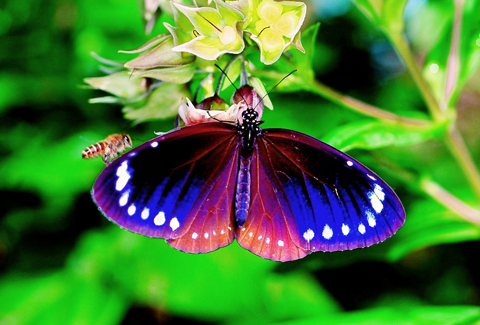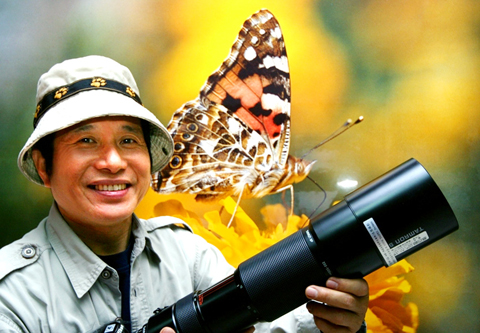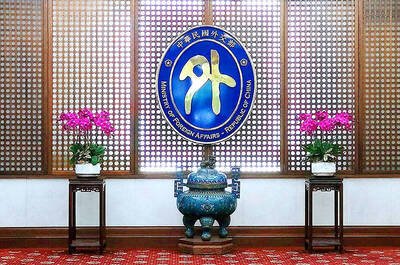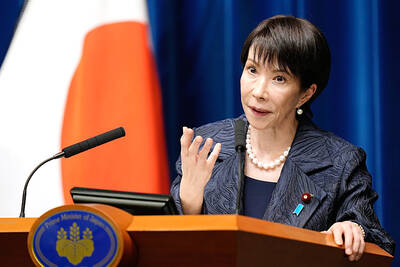He has crashed into a mountain ditch, smashed into a cliff, come face-to-face with a deadly bamboo viper and nearly frozen to death on a mountaintop pursuing his lifelong passion, but he has never been deterred by any of those near fatal experiences — or by opposition from his family.
Tsai Bae-chun (蔡百峻), a photographer better known as “Mr Butterfly,” has been chasing butterflies around for more than 30 years.
He fell in love with butterflies as a child, catching them and framing them in a book to preserve their beauty. But that interest did not become a burning obsession until 1979, when Tsai, at the age of 29, witnessed “in awe” the metamorphosis of a butterfly while visiting a friend in Hualien.

PHOTO: CNA
He said he saw a bunch of eggs hatch the first night, turn into caterpillars on the wall a few days later and then become pupa before emerging as colorful butterflies, an experience that left him obsessed with the fragile insect.
Tsai said he read every book he could lay his hands on to learn about the species. But compared with Japanese reference books on Taiwan’s butterflies, locally published books seemed “slipshod,” he said.
Taiwan at the time was focused solely on rapid economic growth, but after seeing the difference in the books, Tsai felt the country’s pursuit was too narrow.

PHOTO: CNA
“What’s the use of a better economy if there is such a big cultural gap between Taiwan and its neighbor. It was really humiliating,” he said, adding that he then made a vow to one day publish his own pictorial almanac of butterflies endemic to Taiwan to bring the beauty of the “butterfly kingdom” to local residents.
When he finally returned to his home in industrial Kaohsiung City six months later, he knew he could no longer continue the family business — a company that sold cooking oil.
“My mind was set. I wanted to be a butterfly chaser,” Tsai said.
Of Taiwan’s 400 butterfly species, Tsai has recorded 345, but tracking down so many butterflies has not been easy and has led him on plenty of adventures around Taiwan.
In his more “crazy” days, whenever he heard about the appearance of rare butterflies, he would easily cover more than 500km a day on his motorcycle to see them.
Starting out in Kaohsiung, he would ride the Central Cross-Island Highway to Hualien and head south along the east coast to Taitung and Pingtung before returning to Kaohsiung.
Several times, he was so mesmerized by butterflies that he forgot he was driving on a treacherous mountain road and wound up crashing into roadside ditches. One day, while in hot pursuit of an elusive beauty, he crashed his motorcycle into the side of a mountain.
“That was actually fortunate,” he said, “because if it had been on the other side of the road, I would have fallen off a cliff.”
This blind pursuit of butterflies has become his guiding philosophy — “using the dumb way to get the best picture.”
Butterflies like to loiter by riversides, but Tsai believes photographing them from above does not make a good picture, so he gets into position by wading into rivers, braving rapid currents, slippery rocks and, in early spring when some species appear, frigid water.
When a butterfly is perched high on a tree, he often climbs another tree to shoot it from a different angle. If the subject is frightened away, Tsai simply stays in the tree, and waits for it to return.
His methods might seem foolish to other photographers who simply use a big net to catch their prey, release them in a fixed space and photograph them without any worries.
Tsai, however, insists on shooting butterflies in their natural habitat, just as he insists on using micro lenses rather than long-distance lenses to get the best quality.
Chasing butterflies is a solitary job, as the butterfly is a shy creature that is frightened away by moving shadows. Alone in the wild, Tsai has had numerous encounters with leeches and wasps and heard the roars of wild animals, such as black bears.
He remembers one traumatic experience in the bitter cold on a mountain at 2,000m altitude.
“My head was spinning and I had difficulty breathing. I didn’t feel I would live until the next day,” Tsai said.
With no doctors or hospitals nearby, he could only rely on herbs for relief.
Tsai’s success has more than offset these many brushes with danger, such as spotting the rare and elusive broad-tailed swallowtail butterfly, considered by many the queen of butterflies, on Taiping Mountain (太平山) in Yilan County after a search of nearly a decade.
After nearly six years of chasing butterflies and learning butterfly basics — what they eat, when and where they appear, their movements and the trees they like to cling to — Tsai published a picture booklet in 1984 to introduce the butterflies found in Kenting National Park.
The project finally won his family over to his cause after years of opposition.
In May 2007, his collection of 28 butterfly photos was exhibited at the Smithsonian’s National Museum of Natural History, making him the first Asian photographer to have his work displayed at the museum.
Such an honor was the result of more than just his “dumb way to get the best picture.”
He has developed a number of special skills that have enabled him to spot and get closer to his subjects.
He has perfect eyesight and his ability to identify light waves, for example, helps him spot butterflies that excel at camouflage, such as the orange oakleaf, which appears as a withered leaf when it folds its wings. Tsai can spot it because it emits a different light wave than that of a leaf.
Tsai said he has also learned to “communicate” with butterflies by observing their movements. When a butterfly sips nectar from flowers, its wings flap moderately, but the flapping quickens when it is alarmed.
If a butterfly is unwilling to leave a flower, the flapping will pick up to show it is aware of the existence of an encroaching threat.
He has also developed a “dance” that lets him get closer to his target. When he is 5m away, he swings his arms in an exaggerated way to acclimate the butterfly to his presence, and then moves to within 2m at a moderate pace.
For all of Tsai’s recognition and expertise, chasing butterflies is not a money-making endeavor. To support his basic annual expenses of NT$1 million (US$30,300), he has sold three houses in recent years and works as a street vendor from mid-autumn to early spring when there are few butterflies to chase.
Though not wealthy, Tsai uses some of his limited funds to give speeches around the country and offer butterfly-related gifts to children to instill in them the concept of conservation.
Tsai said he would continue his blind pursuit to get people more focused on the environment.
“By getting people to appreciate the beauty of butterflies through my photos, they will naturally want to protect and preserve environments that are suitable for them and eventually harbor a love for the land known as the ‘kingdom of butterflies,’” he said.

The Ministry of Foreign Affairs (MOFA) yesterday voiced dissatisfaction with the Comprehensive and Progressive Agreement for Trans- Pacific Partnership (CPTPP), whose latest meeting, concluded earlier the same day, appeared not to address the country’s application. In a statement, MOFA said the CPTPP commission had "once again failed to fairly process Taiwan’s application," attributing the inaction to the bloc’s "succumbing to political pressure," without elaborating. Taiwan submitted its CPTPP application under the name "Separate Customs Territory of Taiwan, Penghu, Kinmen and Matsu" on Sept. 22, 2021 -- less than a week after China

THE GOOD WORD: More than 100 colleges on both sides of the Pacific will work together to bring students to Taiwan so they can learn Mandarin where it is spoken A total of 102 universities from Taiwan and the US are collaborating in a push to promote Taiwan as the first-choice place to learn Mandarin, with seven Mandarin learning centers stood up in the US to train and support teachers, the Foundation for International Cooperation in Higher Education of Taiwan (FICHET) said. At the annual convention of the American Council on the Teaching of Foreign Languages held over the weekend in New Orleans, Louisiana, a Taiwan Pavilion was jointly run by 17 representative teams from the FICHET, the Overseas Community Affairs Council, the Steering Committee for the Test of Proficiency-Huayu, the

A home-style restaurant opened by a Taiwanese woman in Quezon City in Metro Manila has been featured in the first-ever Michelin Guide honoring exceptional restaurants in the Philippines. The restaurant, Fong Wei Wu (豐味屋), was one of 74 eateries to receive a “Michelin Selected” honor in the guide, while one restaurant received two Michelin stars, eight received one star and 25 were awarded a “Bib Gourmand.” The guide, which was limited to restaurants in Metro Manila and Cebu, was published on Oct. 30. In an interview, Feng Wei Wu’s owner and chef, Linda, said that as a restaurateur in her 60s, receiving an

MORE RETALIATION: China would adopt a long-term pressure strategy to prevent other countries or future prime ministers following in Sanae Takaichi’s steps, an academic said Taiwan should maintain communications with Japan, as Japanese Prime Minister Sanae Takaichi is to lead a revision of security documents, Taiwanese academics said yesterday. Tensions have risen between Japan and China over remarks by Takaichi earlier this month that the use of force against Taiwan would constitute a “survival-threatening situation” for Japan. Prospect Foundation president Lai I-chung (賴怡忠) yesterday said Takaichi’s stance regarding Taiwan is the same as past Japanese prime ministers, but her position is clearer than that of her predecessors Fumio Kishida and Shigeru Ishiba. Although Japan views a “Taiwan contingency” as a “survival-threatening situation,” which would allow its military to